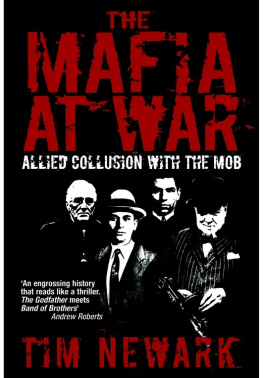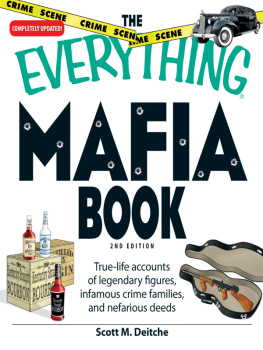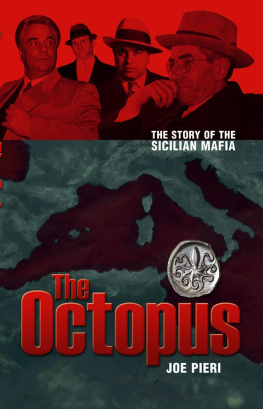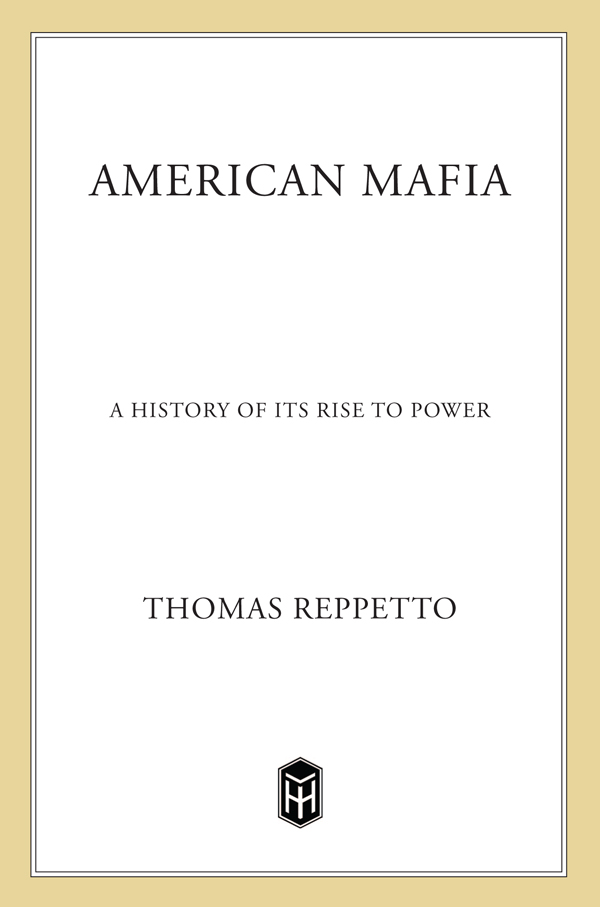Contents
Guide


The author and publisher have provided this e-book to you for your personal use only. You may not make this e-book publicly available in any way. Copyright infringement is against the law. If you believe the copy of this e-book you are reading infringes on the authors copyright, please notify the publisher at: us.macmillanusa.com/piracy.
In memory of Lieutenant Joseph Petrosino, NYPD, murdered while in the performance of his duty, Palermo, Sicily, March 12, 1909
It was the surprise television hit of the year. In the spring of 1951, the normally dull proceedings of a congressional investigation suddenly turned into a fascinating drama that gripped the country. Over eight days in March, a U.S. Senate committee chaired by Estes Kefauver of Tennessee held hearings on organized crime in New York City. All three major networks interrupted their regularly scheduled programming to carry the proceedings live. Household chores, office work, and factory schedules were put aside as people became glued to the TV. The New York sessions were the climax to nine months of hearings in fourteen cities. During the course of the investigation, witnesses were murdered and public officials were disgraced. Most important, shadowy underworld figures were made highly visible.
Throughout the Kefauver Committee proceedings, there was constant reference to a sinister, little-known group that played a major role in American life, including handing out death sentences to those who displeased it. Many of its leaders were men of Italian heritage, and the committee in its final report declared that, in its opinion, an organization known as the Mafia, descended from the Sicilian original, controlled the most lucrative rackets in many major cities and tied together criminal groups throughout the country. Americans had heard tales about the Mafia for over sixty years. Seemingly, the most prestigious legislative body in the country had finally confirmed its existence and its menace.
A generation earlier, Italian gangsters had been largely confined to preying on their countrymen in the Italian districts of big cities and mill and mining towns. Now, in New York, they controlled the countrys largest port and the garment industry that produced most of Americas clothing. Gangsters owned oil wells and premium liquor distributorships. In the 1930s their influence in Hollywood almost led to the takeover of the movie business. For a time the mob played a significant role in the automotive industry. In Chicago, the majority of unions were either run by gangsters or paid tribute to them. Even small cities like Tampa, Florida, and Covington, Kentucky, or tiny resort towns such as Saratoga, New York, and Hot Springs, Arkansas, were held in their grip. It was estimated that the wealth of the national syndicate was greater than that of the richest Fortune 500 corporation.
How had the mobs gained so much power in so short a time? If the Kefauver Committees assertion was to be taken at face value, it was largely the result of the work of a group of ruthless foreigners. Yet many knowledgeable individuals who had worked to bring about the investigation and provided it with valuable counsel did not agree. From their standpoint, such a conclusion was not only wrong but would lead both the public and government down the wrong path. In the aftermath of Kefauver there was a flood of books, movies, television series, and official pronouncements about the menace of the Mafia.
This book details the rise of the Mafia in America, from the 1880s to the 1950s. For much of the twentieth century, the American public, led by the press and movies, has used the word Mafia as shorthand for the Italian-dominated organized crime groups, but it is a misleading term. It places too much emphasis on foreign organizations and alien conspiracies. A more accurate label is American Mafia, which conveys the reality that Italian-dominated gangs arose primarily out of socioeconomic conditions in this country and often worked in partnership with mobsters from other ethnic backgrounds. While never comprising the totality of organized crime, the American Mafia formed the most influential and cohesive element in the loosely organized national crime syndicate that emerged in the 1930s.
The use of the Mafia term is also seen as demeaning to a particular ethnic group. Tragically, during the period under study a hardworking, law-abiding, and patriotic people were frequently stigmatized by the sins of a few of their members. Yet many of those who fought the hardest against the American Mafia were themselves of Italian heritage.
Various reasons have been offered for the American Mafias swift ascent to power. One of the most popular arises from a long history of anti-immigrant sentiment. Early in the twentieth century, newspapers used such phrases as cruel, treacherous, vindictive, and violent to describe Italians. In 1903, a U.S. Secret Service chief called the Mafia the most secret and terrible organization in the world. Such declarations fostered the belief that Italians succeeded because they were a unique group of super-criminals. But powerful, well-entrenched organized crime groups were in existence long before the waves of Italians arrived. Early in the nineteenth century Ike Rynders, an exMississippi riverboat gambler, controlled both Tammany Hall and the gangs of New York. After the Civil War, boss gambler Mike McDonald was the czar of Chicago politics, and at the turn of the century, Jerry Bassity was the vice lord of San Francisco.
A more benign, ethnically based explanation of the American Mafias success holds that it was a combination of two factors: natural succession and luck. According to this theory, as the Irish and other groups moved into the middle class they were less likely to be represented in criminal activity, so the late-arriving Italians filled the void, just at the time when Prohibition was adding vast revenues to organized crimes coffers.
The ethnic succession argument can be overstated, since it was not universal. The idea that it happened everywhere comes from the common mistake of assuming that whatever took place in New York and Chicago also occurred in the rest of the country, though even in those cities, gangsters of other nationalities worked with Italian bosses. In Cleveland, the premier organized crime group continued to be a Jewish gang. In some other cities, Italian criminal incursions were repulsed. In places like New Orleans, Italians were invited in and allowed to remain as long as they accepted a subordinate role.
One element of the culture of southern Italian criminals did equip its members for success in American organized crimetheir businesslike approach. Non-Italian gangs grew mostly out of neighborhood bonds formed by young men who committed ordinary crimes such as robbery, burglary, or assault. Even as Prohibition transformed these gangs into powerful mobs, they continued to operate much as they had in their wild early days, shooting at the drop of an insult; their organizations were largely extensions of street gangs. When death or imprisonment removed leaders of Irish, Jewish, or Polish gangs, their organizations usually collapsed. In contrast, despite their reputation for violence and ruthlessness, Italian leaders eschewed senseless mayhem in favor of more rational methods. Men like Chicagos Johnny Torrio and New Yorks Lucky Luciano displayed remarkable organizational skills. Torrio was a quiet little opera-loving family man and Luciano a tough drug dealer who squired Broadway and Hollywood beauties, but both built their mobs along corporate lines. They parceled out territories and adopted rules to provide for the arbitration of disputes. In the mold of Rockefeller or Morgan, they formed syndicates to end wasteful competition. Like other businessmen, they established national associations to promote common interests. When they passed from the scene, their organizations remained, lasting to the present. Thus while Prohibition was a lucky break for all gangsters, the Italians were better able to profit from it.




















